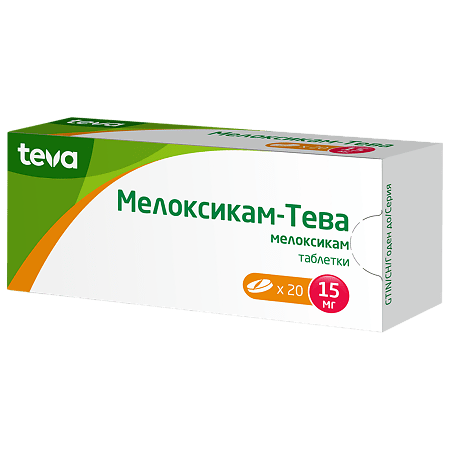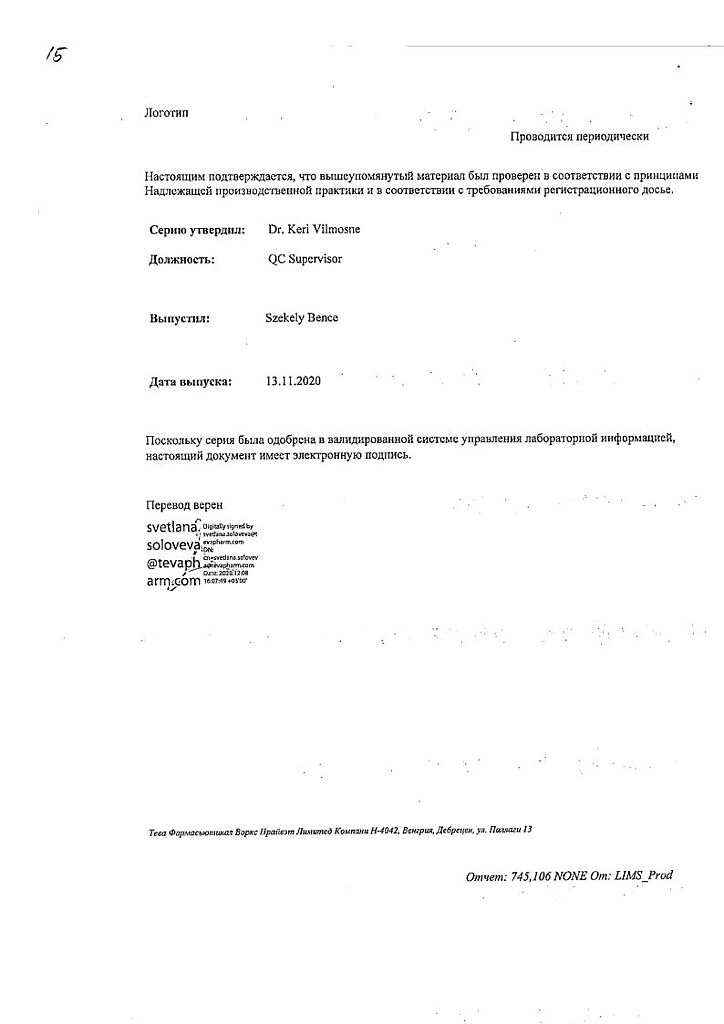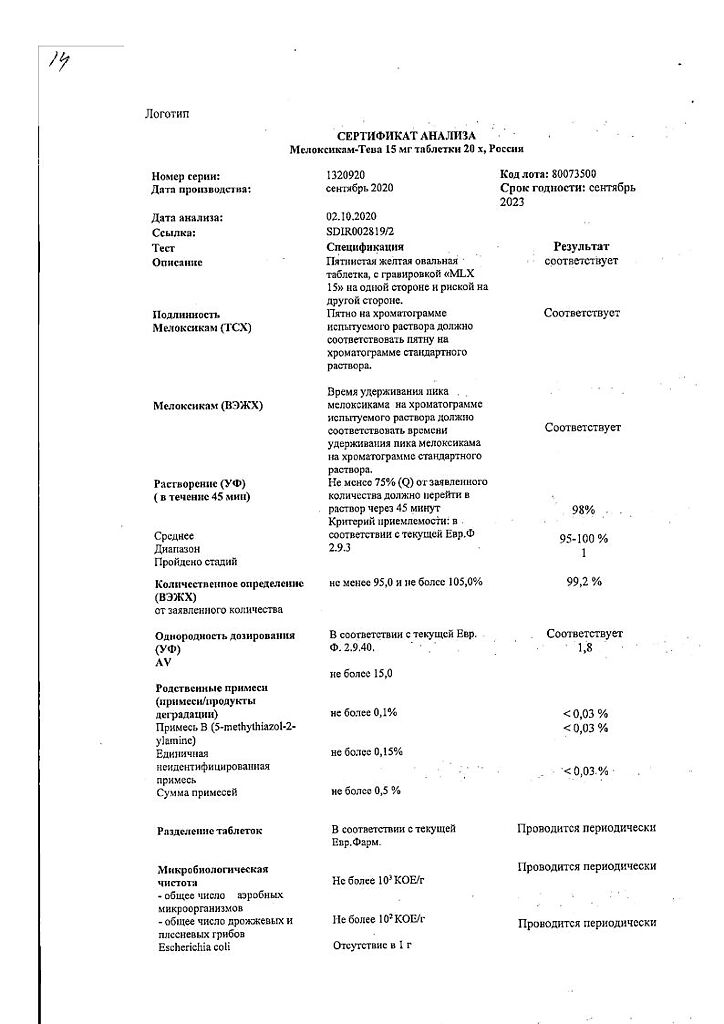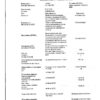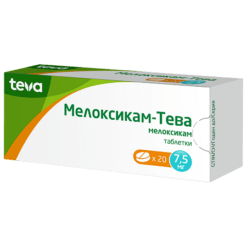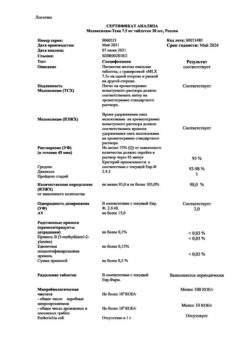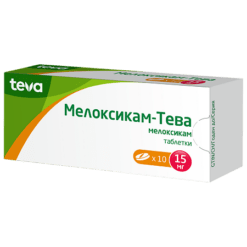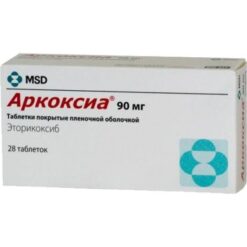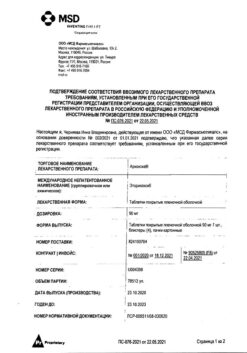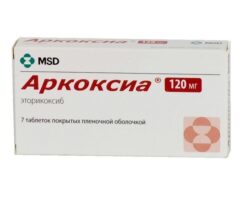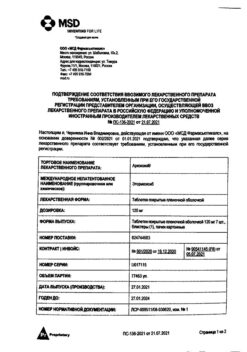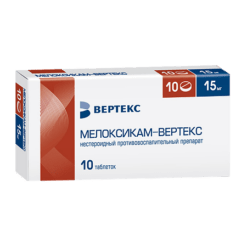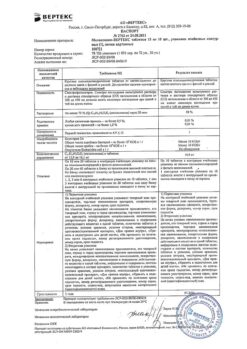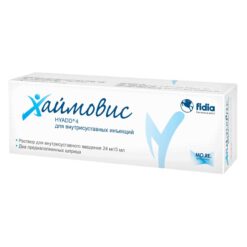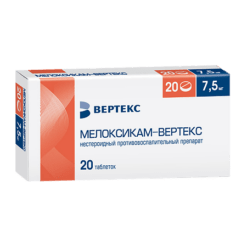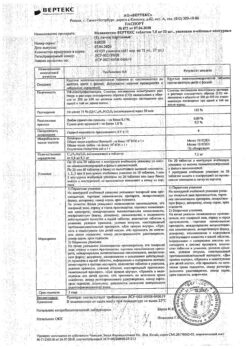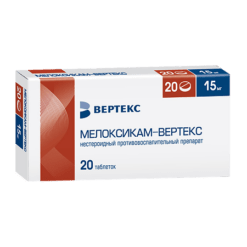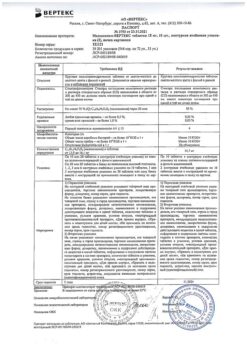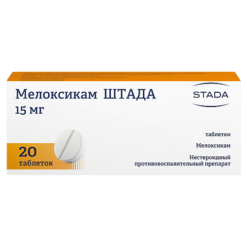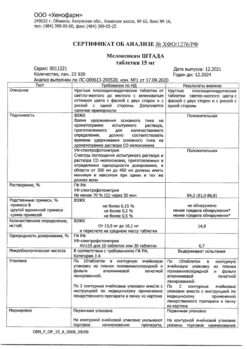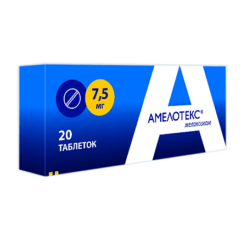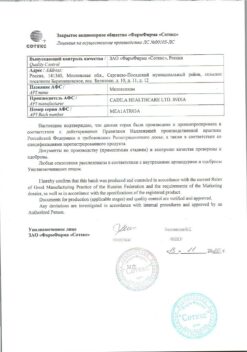No products in the cart.
Meloxicam-Teva, tablets 15 mg 20 pcs
€10.82 €9.47
Description Non-steroidal anti-inflammatory drug (NSAIDs)
ATC:
M.01.A.C.06 Meloxicam
M.01..A.C Oxycams
Pharmacodynamics:
Meloxicam is a nonsteroidal anti-inflammatory drug with anti-inflammatory and antipyretic effects. Its anti-inflammatory effect is associated with inhibition of the enzymatic activity of cyclooxygenase-2 (COX-2), involved in prostaglandin biosynthesis in the area of inflammation. To a lesser extent, meloxicam acts on cyclooxygenase-1 (COX-1), involved in the synthesis of prostaglandin, which protects the mucosa of the gastrointestinal tract (GIT) and is involved in the regulation of blood flow in the kidneys.
Pharmacokinetics:
absorption.
Meloxicam is well absorbed from the gastrointestinal tract, as evidenced by the high absolute bioavailability (90%) after oral administration. After a single use of meloxicam maximum concentration of the drug in plasma is achieved within 5-6 hours. Simultaneous intake of food and inorganic antacids does not change absorption. When the drug is used orally (in doses of 7.5 and 15 mg), its concentrations are proportional to the doses. Steady-state pharmacokinetics is achieved within 3-5 days. Range of differences between maximal and basal drug concentrations after a single daily dose is relatively small, 0.4-1.0 µg/ml with 7.5 mg dose, and 0.8-2.0 µg/ml with 15 mg dose (Cmin and Cmax values during steady state pharmacokinetics are indicated, respectively), although values higher than this range have been observed.
The maximum plasma concentration of meloxicam during steady state pharmacokinetics is reached 5-6 hours after oral administration.
Distribution.
Meloxicam binds very well to plasma proteins, mainly to albumin (99%). It penetrates the synovial fluid, the concentration in the synovial fluid is about 50% of the plasma concentration. The volume of distribution after repeated oral administration of meloxicam (in doses from 7.5 mg to 15 mg) is about 16 l, with a coefficient of variation of 11 to 32%.
Metabolism.
Meloxicam is almost completely metabolized in the liver to form 4 pharmacologically inactive derivatives. The main metabolite, 5′-carboxymeloxicam (60% of the dose value), is formed by oxidation of the intermediate metabolite, 5′-hydroxymethylmeloxicam, which is also excreted, but to a lesser extent (9% of the dose value). In vitro studies have shown that CYP2C9 plays an important role in this metabolic transformation, CYP3A4 isoenzyme has additional importance. Peroxidase, the activity of which probably varies individually, is involved in the formation of the other two metabolites (constituting, respectively, 16% and 4% of the drug dose value).
Evacuation.
Extracted equally via the intestine and the kidneys, mainly as metabolites. Less than 5% of daily dose is excreted unchanged in feces, in urine the drug is excreted unchanged only in trace amounts. The average half-life of meloxicam varies from 13 to 25 hours.
Plasma clearance averages 7-12 ml/min after a single dose of meloxicam.
Inadequate hepatic and/or renal function. Lack of hepatic function and mild renal insufficiency has no significant effect on the pharmacokinetics of meloxicam. The elimination rate of meloxicam from the body is significantly higher in patients with moderately severe renal insufficiency. Meloxicam binds worse with plasma proteins in patients with terminal renal failure. In terminal renal failure increased volume of distribution can lead to higher concentrations of free meloxicam, so in these patients the daily dose should not exceed 7.5 mg.
Elderly patients. Elderly patients have similar pharmacokinetic parameters compared to younger patients. Elderly patients have slightly lower mean plasma clearance during equilibrium pharmacokinetics than younger patients. Elderly women have higher AUC values (area under the concentration-time curve) and a longer half-life compared to younger patients of both sexes.
.
Indications
Indications
Symptomatic treatment:
osteoarthritis (arthrosis, degenerative joint diseases), including with a pain component;
rheumatoid arthritis;
ankylosing spondylitis.
Pharmacological effect
Pharmacological effect
Non-steroidal anti-inflammatory drug (NSAID)
ATX:
M.01.A.C.06 Meloxicam
M.01.A.C Oxycams
Pharmacodynamics:
Meloxicam is a non-steroidal anti-inflammatory drug with anti-inflammatory and antipyretic effects. The anti-inflammatory effect is associated with inhibition of the enzymatic activity of cyclooxygenase-2 (COX-2), involved in the biosynthesis of prostaglandin in the area of inflammation. To a lesser extent, meloxicam acts on cyclooxygenase-1 (COX-1), which is involved in the synthesis of prostaglandin, which protects the mucous membrane of the gastrointestinal tract (GIT) and takes part in the regulation of blood flow in the kidneys.
Pharmacokinetics:
Absorption.
Meloxicam is well absorbed from the gastrointestinal tract, as evidenced by its high absolute bioavailability (90%) after oral administration. After a single use of meloxicam, the maximum concentration of the drug in plasma is achieved within 5-6 hours. Concomitant intake of food and inorganic antacids does not alter absorption. When using the drug orally (in doses of 7.5 and 15 mg), its concentrations are proportional to the doses. Steady state pharmacokinetics is achieved within 3-5 days. The range of differences between the maximum and basal concentrations of the drug after taking it once a day is relatively small and is 0.4-1.0 μg/ml when using a dose of 7.5 mg, and 0.8-2.0 μg/ml when using a dose of 15 mg (Cmin and Cmax values are given, respectively, during the steady state of pharmacokinetics), although values outside the specified range were also noted.
The maximum concentration of meloxicam in plasma during the period of steady state pharmacokinetics is achieved 5-6 hours after oral administration.
Distribution.
Meloxicam binds very well to plasma proteins, mainly albumin (99%). Penetrates into synovial fluid, the concentration in synovial fluid is approximately 50% of the concentration in plasma. The volume of distribution after repeated oral administration of meloxicam (in doses ranging from 7.5 mg to 15 mg) is approximately 16 L, with a coefficient of variation ranging from 11 to 32%.
Metabolism.
Meloxicam is almost completely metabolized in the liver to form 4 pharmacologically inactive derivatives. The main metabolite, 5′-carboxymeloxicam (60% of the dose), is formed by oxidation of the intermediate metabolite, 5′-hydroxymethylmeloxicam, which is also excreted, but to a lesser extent (9% of the dose). In vitro studies have shown that CYP2C9 plays an important role in this metabolic transformation, and the CYP3A4 isoenzyme is of additional importance. Peroxidase is involved in the formation of the other two metabolites (constituting, respectively, 16% and 4% of the drug dose), the activity of which probably varies individually.
Excretion.
It is excreted equally through the intestines and kidneys, mainly in the form of metabolites. In unchanged form, less than 5% of the daily dose is excreted in feces; in urine, unchanged, the drug is found only in trace amounts. The average half-life of meloxicam varies from 13 to 25 hours.
Plasma clearance averages 7-12 ml/min after a single dose of meloxicam.
Insufficiency of liver and/or kidney function. Insufficiency of liver function, as well as mild renal failure, do not have a significant effect on the pharmacokinetics of meloxicam. The rate of elimination of meloxicam from the body is significantly higher in patients with moderate renal failure. Meloxicam binds less well to plasma proteins in patients with end-stage renal failure. In end-stage renal failure, an increase in volume of distribution may result in higher concentrations of free meloxicam, so in these patients the daily dose should not exceed 7.5 mg.
Elderly patients. Elderly patients compared to young patients have similar pharmacokinetic parameters. In elderly patients, the average plasma clearance during steady-state pharmacokinetics is slightly lower than in younger patients. Elderly women have higher AUC values (area under the concentration-time curve) and a longer half-life compared to younger patients of both sexes.
Special instructions
Special instructions
Patients suffering from diseases of the gastrointestinal tract should be monitored regularly. If ulcerative lesions of the gastrointestinal tract or gastrointestinal bleeding occur, Meloxicam-Teva should be discontinued.
Gastrointestinal ulcers, perforation, or bleeding may occur at any time during the use of NSAIDs, with or without warning symptoms or a history of serious gastrointestinal complications. The consequences of these complications are generally more serious in older people.
When using the drug Meloxicam-Teva, serious skin reactions may develop, such as exfoliative dermatitis, Stevens-Johnson syndrome, toxic epidermal necrolysis. In this regard, special attention should be paid to patients who report the development of adverse events from the skin and mucous membranes, as well as hypersensitivity reactions to the drug, especially if such reactions were observed during previous courses of treatment. The development of such reactions is observed, as a rule, during the first month of treatment. If the first signs of a skin rash, changes in the mucous membranes or other signs of hypersensitivity appear, discontinuation of the use of Meloxicam-Teva should be considered.
Cases have been described when taking NSAIDs to increase the risk of developing serious cardiovascular thrombosis, myocardial infarction, angina, possibly fatal. This risk increases with long-term use of the drug, as well as in patients with a history of the above diseases and predisposed to such diseases.
NSAIDs inhibit the synthesis of prostaglandins in the kidneys, which are involved in maintaining renal perfusion. The use of NSAIDs in patients with reduced renal blood flow or reduced circulating blood volume may lead to decompensation of latent renal failure. After discontinuation of NSAIDs, renal function usually returns to baseline levels. Elderly patients are most at risk of developing this reaction; patients with dehydration, chronic heart failure, liver cirrhosis, nephrotic syndrome or acute renal dysfunction; patients simultaneously taking diuretics, angiotensin-converting enzyme inhibitors, angiotensin II receptor antagonists; as well as patients who have undergone major surgical procedures that lead to hypovolemia. In such patients, diuresis and renal function should be carefully monitored when initiating therapy.
The use of NSAIDs in combination with diuretics can lead to sodium, potassium and water retention, as well as a decrease in the natriuretic effect of diuretics. As a result, predisposed patients may experience increased signs of heart failure or hypertension. Therefore, such patients must be closely monitored and adequate hydration maintained. Before starting treatment, a kidney function test is necessary.
In case of combination therapy, renal function should also be monitored.
When using the drug Meloxicam-Teva (as well as most other NSAIDs), an episodic increase in the activity of transaminases in the blood serum or other indicators of liver function is possible. In most cases, this increase was small and transitory. If the identified changes are significant or do not decrease over time, the drug Meloxicam-Teva should be discontinued and the identified laboratory changes should be monitored.
Weakened or malnourished patients may be less able to tolerate adverse events and should be monitored closely.
Like other NSAIDs, Meloxicam-Teva can mask the symptoms of an underlying infectious disease.
As a drug that inhibits cyclooxygenase/prostaglandin synthesis, Meloxicam-Teva may have an effect on fertility and is therefore not recommended for women who have difficulty conceiving. In this regard, in women undergoing examination for this reason, it is recommended to discontinue the drug Meloxicam-Teva.
In patients with mild or moderate renal impairment (creatinine clearance more than 25 ml/min), no dose adjustment is required.
In patients with liver cirrhosis (compensated), no dose adjustment is required.
Impact on the ability to drive vehicles and machinery
No special studies have been conducted on the effect of the drug on the ability to drive vehicles and operate machinery. However, when operating vehicles and machinery, the possibility of developing dizziness, drowsiness, visual impairment or other disorders of the nervous system should be taken into account. Patients should be careful when operating vehicles and machinery.
Active ingredient
Active ingredient
Meloxicam
Composition
Composition
1 tablet contains: active ingredient meloxicam 7.5/15.0 mg; excipients: lactose monohydrate 77.2/69.7 mg, microcrystalline cellulose 56.0/56.0 mg, sodium citrate dihydrate 18.0/18.0 mg, povidone K30 6.0/6.0 mg, crospovidone 12.0/12.0 mg, colloidal silicon dioxide 1.5/1.5 mg, magnesium stearate 1.8/1.8 mg.
Pregnancy
Pregnancy
Pregnancy
The use of Meloxicam-Teva is contraindicated during pregnancy.
Breast-feeding
It is known that NSAIDs pass into breast milk, therefore the use of Meloxicam-Teva during breastfeeding is contraindicated.
Fertility
As a drug that inhibits cyclooxygenase/prostaglandin synthesis, Meloxicam-Teva may affect fertility and is therefore not recommended for women planning pregnancy. Meloxicam may delay ovulation. In this regard, in women who have problems conceiving and are undergoing examination for such problems, it is recommended to discontinue the drug Meloxicam-Teva.
Contraindications
Contraindications
Hypersensitivity to the active ingredient or auxiliary components of the drug. There is a possibility of cross-sensitivity to acetylsalicylic acid and other NSAIDs.
Complete or incomplete combination of bronchial asthma, recurrent polyposis of the nose and paranasal sinuses and intolerance to acetylsalicylic acid or other NSAIDs (including a history).
Erosive and ulcerative lesions of the stomach and duodenum in the acute stage or recently suffered.
Inflammatory bowel diseases (Crohn’s disease, ulcerative colitis) in the acute stage.
Severe liver failure.
Severe renal failure (if hemodialysis is not performed, creatinine clearance less than 30 ml/min, and also with confirmed hyperkalemia), progressive kidney disease.
Active gastrointestinal bleeding, recent cerebrovascular bleeding, or an established diagnosis of diseases of the blood coagulation system.
Severe uncontrolled heart failure.
Pregnancy.
Breastfeeding period.
Therapy of perioperative pain during coronary artery bypass surgery.
Children’s age up to 12 years.
Rare hereditary galactose intolerance (the maximum daily dose of the drug with a meloxicam dosage of 7.5 mg and 15 mg contains 47 mg and 20 mg of lactose, respectively).
With caution
Coronary heart disease.
Cerebrovascular diseases.
Chronic heart failure.
Renal failure (creatinine clearance 30-60 ml/min).
Dyslipidemia/hyperlipidemia.
Diabetes mellitus.
Peripheral arterial diseases.
Smoking.
History of gastrointestinal tract diseases (peptic ulcer of the stomach and duodenum, liver disease).
Old age.
Long-term use of NSAIDs.
Frequent drinking of alcohol.
Concomitant therapy with the following drugs: anticoagulants (including warfarin), antiplatelet agents, oral glucocorticoids (for example, prednisolone), selective serotonin reuptake inhibitors (including citalopram, fluoxetine, paroxetine, sertraline).
Side Effects
Side Effects
Adverse reactions that were considered possible to be associated with the use of meloxicam are described below.
The incidence of adverse reactions within systemic organ classes was determined in accordance with the recommendations of the World Health Organization: very often (≥ 1/10); often (≥ 1/100 < 1/10); uncommon (≥ 1/1000 < 1/100); rare (≥ 1/10000 < 1/1000); very rare (< 1/10000); frequency unknown (cannot be estimated from available data).
From the blood and lymphatic system: infrequently – anemia; rarely – changes in the number of blood cells, including changes in the leukocyte formula, leukopenia, thrombocytopenia; very rare: agranulocytosis*.
From the immune system: infrequently – other immediate hypersensitivity reactions; frequency unknown – anaphylactic shock (with intramuscular injection), anaphylactoid reactions.
From the nervous system: often – headache; infrequently – dizziness, drowsiness.
Mental disorders: often – mood changes, nightmares; frequency unknown – confusion, disorientation.
From the organ of vision: rarely – conjunctivitis, visual impairment, including blurred vision.
From the organ of hearing: infrequently – vertigo; rarely – tinnitus.
From the gastrointestinal tract: often – abdominal pain, dyspepsia, diarrhea, nausea, vomiting; uncommon – constipation, bloating, stomatitis, gastritis, belching, hidden or obvious gastrointestinal bleeding**; rarely – gastroduodenal ulcers, colitis, esophagitis; very rarely – perforation of the gastrointestinal tract; frequency unknown – pancreatitis.
From the liver: infrequently – transient changes in liver function indicators (for example, increased activity of transaminases or bilirubin); very rarely – hepatitis.
From the skin and subcutaneous tissues: infrequently – angioedema, itching, skin rash; rarely – toxic epidermal necrolysis, Stevens-Johnson syndrome, urticaria; very rarely – bullous dermatitis, erythema multiforme; frequency unknown – photosensitivity reactions.
From the respiratory system: rarely – bronchial asthma in patients with allergies to acetylsalicylic acid or other NSAIDs.
From the heart: rarely – palpitations, frequency unknown – heart failure (associated with taking NSAIDs).
From the side of blood vessels: infrequently – increased blood pressure, a feeling of a “rush” of blood to the face.
From the kidneys and urinary tract: infrequently – hyperkalemia, changes in renal function indicators (increased levels of creatinine and/or urea in the blood serum), urinary disorders, including acute urinary retention; very rarely – acute renal failure in patients with risk factors (see section “Special instructions”).
General disorders: uncommon – edema, including edema of the lower extremities.
Description of selected adverse reactions
*A predisposing factor for the occurrence of agranulocytosis is the simultaneous use of potentially myelotoxic drugs, in particular methotrexate.
**Gastrointestinal bleeding, ulceration, or perforation may be fatal.
As with other NSAIDs, the possibility of interstitial nephritis, glomerulonephritis, renal medullary necrosis, and nephrotic syndrome cannot be excluded.
Interaction
Interaction
Other prostaglandin synthesis inhibitors, including glucocorticoids and salicylates: Concomitant use with meloxicam increases the risk of ulceration in the gastrointestinal tract and gastrointestinal bleeding (due to synergistic action). Concomitant use with other NSAIDs is not recommended.
Anticoagulants for oral administration, heparin for systemic use, thrombolytic agents: simultaneous use with meloxicam increases the risk of bleeding. In case of simultaneous use, careful monitoring of the blood coagulation system is necessary.
Antiplatelet drugs, serotonin reuptake inhibitors: concomitant use with meloxicam increases the risk of bleeding due to inhibition of platelet function. In case of simultaneous use, careful monitoring of the blood coagulation system is necessary.
Lithium preparations: NSAIDs increase plasma lithium levels by decreasing renal excretion. The simultaneous use of meloxicam with lithium preparations is not recommended. If simultaneous use is necessary, careful monitoring of plasma lithium concentrations is recommended throughout the course of lithium use.
Methotrexate: NSAIDs reduce the secretion of methotrexate by the kidneys, thereby increasing its plasma concentration. The simultaneous use of meloxicam and methotrexate (at a dose of more than 15 mg per week) is not recommended. In case of simultaneous use, careful monitoring of renal function and blood count is necessary. Meloxicam may increase the hematological toxicity of methotrexate, especially in patients with impaired renal function. When meloxicam and methotrexate are used together for 3 days, the risk of increased toxicity of the latter increases.
Contraception: There is evidence that NSAIDs may reduce the effectiveness of intrauterine contraceptive devices, but this has not been proven.
Diuretics: the use of NSAIDs in case of dehydration in patients is accompanied by the risk of developing acute renal failure.
Antihypertensive drugs (beta-blockers, angiotensin-converting enzyme inhibitors, vasodilators, diuretics): NSAIDs reduce the effect of antihypertensive drugs due to the inhibition of prostaglandins that have vasodilating properties.
Angiotensin II receptor antagonists: when used together with NSAIDs, they increase the decrease in glomerular filtration, which can lead to the development of acute renal failure, especially in patients with impaired renal function.
Cholestyramine: By binding to meloxicam in the gastrointestinal tract, cholestyramine causes it to be eliminated more quickly.
Cyclosporine: NSAIDs, by acting on renal prostaglandins, may increase the nephrotoxicity of cyclosporine.
When co-administering medicinal products with meloxicam that have a known ability to inhibit CYP2C9 and/or CYP3A4 (or are metabolized by these enzymes), the possibility of pharmacokinetic interaction should be taken into account.
The possibility of interaction with antidiabetic drugs for oral administration cannot be excluded.
With the simultaneous use of antacids, cimetidine, digoxin and furosemide, no significant pharmacokinetic interactions were identified.
Overdose
Overdose
There is insufficient data on cases associated with drug overdose. In severe cases, symptoms consistent with NSAID overdose are likely to be present:
drowsiness, impaired consciousness, nausea, vomiting, epigastric pain, gastrointestinal bleeding, changes in blood pressure, acute renal failure, respiratory arrest, asystole.
Treatment: no known antidote; in case of drug overdose, gastric contents should be evacuated and general supportive therapy should be performed. Cholestyramine accelerates the elimination of meloxicam.
Storage conditions
Storage conditions
The drug should be stored in a dry place, protected from light, at a temperature not exceeding 25°C.
Shelf life
Shelf life
3 years.
Manufacturer
Manufacturer
Teva Pharmaceutical Works Private Limited Company, Hungary
Additional information
| Shelf life | 3 years. |
|---|---|
| Conditions of storage | The drug should be stored in a dry place protected from light at a temperature not exceeding 25 ° C. |
| Manufacturer | Teva Pharmaceutical Works Production Limited Company, Hungary |
| Medication form | pills |
| Brand | Teva Pharmaceutical Works Production Limited Company |
Other forms…
Related products
Buy Meloxicam-Teva, tablets 15 mg 20 pcs with delivery to USA, UK, Europe and over 120 other countries.

